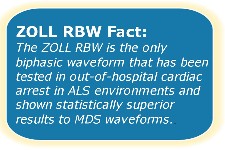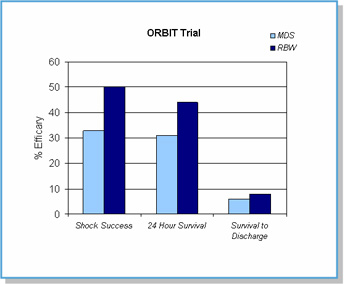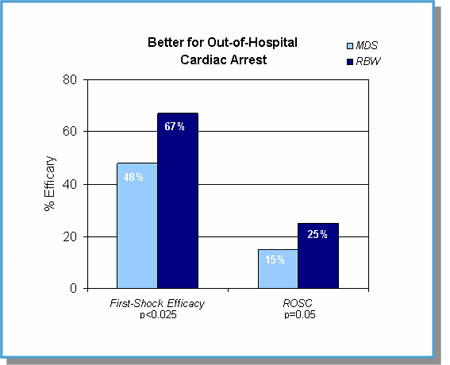Biphasic Technology - Sudden Cardiac Arrest
Superior for Defibrillation of Out-of-Hospital Cardiac Arrest
Results from two clinical trials using the ZOLL Rectilinear Biphasic™ waveform (RBW) in out-of-hospital cardiac arrest ALS response systems have recently been presented. Both studies confirm the superiority of the ZOLL RBW over monophasic damped sine (MDS) waveforms in out-of-hospital cardiac arrest.*
Stothert et al. also recently published the results from a retrospective clinical trial of 294 patients treated for cardiac arrest. Results showed a 40% increase in first shock efficacy and a 67% increase in return of spontaneous circulation with normal sinus rhythm.
The Trend Continues in Out-of-Hospital Cardiac Arrest
Stothert et al. Prehospital Emergency Care. 2002; 6:149-150 (abstract).
Results from the Out-of-hospital Rectilinear Biphasic Intervention Trial (ORBIT) showed the ZOLL RBW to have superior efficacy to MDS waveforms in out-of-hospital cardiac arrest treated with advanced life support (ALS). Unlike other out-of-hospital biphasic defibrillation trials, the ORBIT trial used a much more challenging protocol with ALS responders instead of first responders, and a definition of success as organized electrical rhythms rather than absence of VF. This makes the 55% increase in efficacy even more significant in the face of long down times. Further, the ORBIT trial is the only out-of-hospital biphasic study to show statistically significant improvement in 24-hour survival (Figure 1). |
 |
 |
Read on to uncover the unique advantages of ZOLL's Rectilinear Biphasic waveform:
Principles of Electricity
More Current at 200 J than other biphasic waveforms at 360 J
Optimal Duration for Defibrillation Shocks
Superior for Cardioversion of Atrial Fibrillation
Superior for Defibrillation of Ventricular Fibrillation
Superior for Defibrillation of Out-of-Hospital Cardiac Arrest
Pediatric Biphasic Recommendations
Bibliography
*The data demonstrates the equivalent efficacy of low energy rectilinear biphasic shocks compared to standard high energy monophasic shocks for transthoracic defibrillation for all patients in VT/VF at the 95% confidence level. The data also demonstrate the superior efficacy of low energy rectilinear biphasic shocks compared to standard high energy monophasic shocks in patients in VT/VF with high transthoracic impedance at the 90% confidence level.

